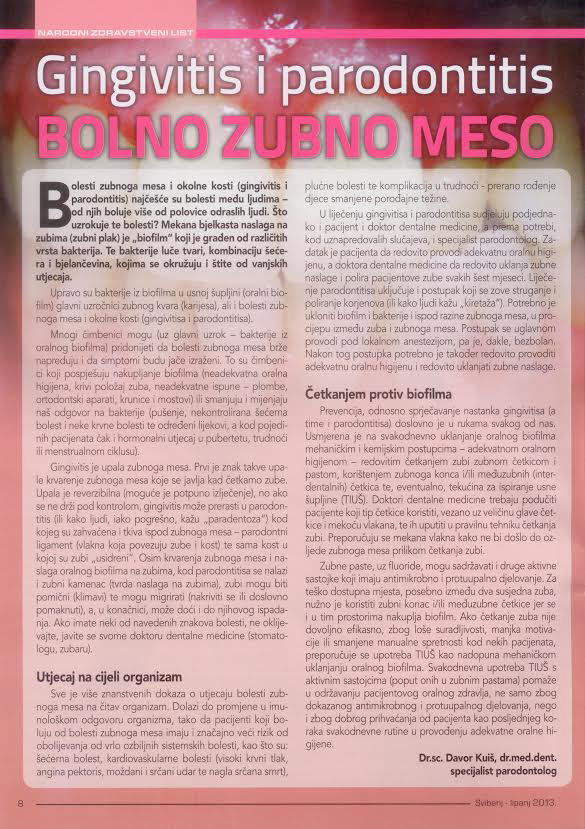The bacteria from the biofilm in the oral cavity (oral biofilm) are the main cause of dental decay (cavities), gum disease and the disease of the surrounding bone (gingivitis and periodontitis).
Many factors may (along with the main cause – the bacteria contained in the oral biofilm) contribute to a faster gum disease development and make the symptoms even stronger. Those factors either contribute in building the biofilm (inadequate oral hygiene, wrong teeth alignment, inadequate teeth fillings, braces, crowns and bridges), or diminish and change our organism’s response to bacteria (smoking, uncontrolled diabetes, some blood related diseases, some medicaments, and in some cases even hormonal influence in puberty, pregnancy or menstrual cycle.)
Gingivitis is gum inflammation. The first sign of the inflammation is bleeding while brushing your teeth. Fortunately, it can be fully cured, but if not kept under control, it can lead to periodontitis (or “periodontal disease”, as people like to incorrectly refer to it), which is the inflammation of the area below gums – the periodontal tissue (fibers which bind our teeth to the jawbone), and the jawbone itself, in which the teeth are „anchored“. Apart from the gum bleeding and the oral biofilm built up on teeth, periodontitis also means tartar buildups, teeth can get wobbly, crooked or even move, and ultimately – fall out. If you notice any of the above-mentioned symptoms of either gingivitis or periodontitis, don’t hesitate to contact your dentist (DMD).
Influence on the entire organism
There are ever more scientific proves of the influence of gum disease on the entire human organism. It changes the immune system’s response, so patients who suffer from gum disease may be put at greater risk of a number of serious medical conditions, such as: diabetes, cardiovascular diseases (high blood pressure, angina pectoris, stroke, heart attack, sudden cardiac death), lung diseases, and complications of pregnancy (premature birth of low-birth-weight newborns).
Treatment of gingivitis and periodontitis requires a good patient – dentist cooperation. Severe cases sometimes even require a periodontology specialist. The patient’s task is to maintain proper oral hygiene, and the dentist must remove any dental buildups and polish patient’s teeth every six months. The treatment also includes a procedure called root scaling and planing (or as some people say, “curettage”). It is necessary to remove all the biofilm and bacteria under the gum level, in the area between teeth and gums. The procedure is painless because it is performed under local anesthesia. After the procedure, it is highly important to continue with the proper oral hygiene and to get the dental buildups regularly removed.
Brushing against biofilm
The prevention of diseases such as gingivitis and periodontitis is literally in our own hands. Maintaining the habit of proper oral hygiene by brushing our teeth with a brush and toothpaste, flossing and rinsing the oral cavity, we mechanically and chemically remove the oral biofilm on a daily basis. Dentists should advise their patients on the type of brush they should use (considering the size of the head, the softness of its bristles), and educate them about proper tooth-brushing techniques. It is advised to use brushes with soft bristles to avoid any possible damage of the gums while brushing.
Toothpastes, beside flouride, may contain other active substances that have antimicrobial and anti-inflamatory properties. Flossing is necessary for the inaccessible areas, such as between two teeth, because the oral biofilm can build up there, too. If brushing teeth is not effective enough (when it comes to lack of motivation, poor compliance or poor manual dexterity), some patients are advised to rinse the oral cavity with mouthwash as an additional help in removing the oral biofilm. Daily use of mouthwash with active substances similar to those contained in toothpaste can help patients maintain their oral health, not only because of its anti-inflammatory and antimicrobial action, but also because it is highly accepted by patients as the final step of their routine when it comes to maintaining the proper oral hygiene.
Dr.sci. Davor Kuiš dr.med.dent. specialist in periodontics


Do you have friends who might be interested in this article? Please, share it! Thank you! 🙂

